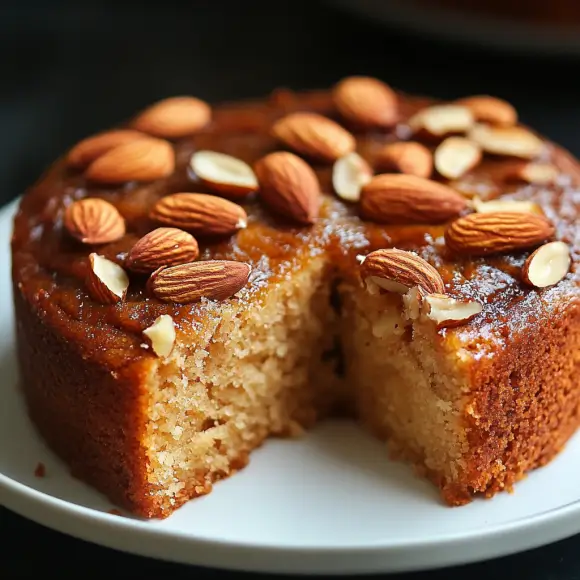- Introduction to Almond Nut Cake
- History of Almonds in Baking
- Step-by-Step Preparation
- Presentation and Serving Ideas
- Storage and Shelf Life
- Tips for Scaling Recipes for Larger Batche
- Nutritional Information
- Health Benefits of Almond-Based Desserts
- Frequently Asked Questions
- FAQS:
- Conclusion and Final Thoughts
Introduction to Almond Nut Cake
Almond nut cake is a timeless dessert celebrated for its moist texture and nutty richness. Whether enjoyed as a teatime treat or a special occasion indulgence, this cake never fails to impress. In addition, the combination of almonds, flour, and sugar creates a delightful harmony of flavors. What’s more, almond nut cakes cater to a wide range of diets, as they can easily be made gluten-free or dairy-free.
The charm of this cake lies in its simplicity. However, mastering the almond nut cake recipe requires attention to detail. Thus, in this guide, we’ll take you through everything you need to know, from its historical roots to creative variations.
History of Almonds in Baking
Almonds have been a staple ingredient in baking for centuries. Originating in the Middle East, almonds made their way into European desserts during the Middle Ages. Because of their versatility and nutritional value, almonds became a key ingredient in classic European cuisine. Over time, almond flour and paste became essential components of cakes and pastries.
The almond nut cake traces its roots to regions where almonds were plentiful, like Spain and Italy. As a result, modern baking techniques have since blended traditional almond flavors with innovative ingredients. Consequently, almond nut cake remains a beloved recipe across the globe, celebrated for its rich taste and cultural significance.
The almond nut cake traces its roots to regions where almonds were plentiful, like Spain and Italy. As a result, modern baking techniques have since blended traditional almond flavors with innovative ingredients. Therefore, almond nut cake remains a beloved recipe across the globe, celebrated for its rich taste and cultural significance.
Ingredients for Almond Nut Cake
To achieve the perfect almond nut cake, it’s crucial to use the right ingredients. Indeed, each component contributes to the cake’s unique texture and flavor. Below, you’ll find the essentials:
Key Ingredients:
- 2 cups of almond flour (guarantees a moist and dense texture)
- 1 cup of all-purpose flour (optional for added structure)
- 1 cup granulated sugar or honey (balances the nutty flavor with sweetness)
- 1/2 cup unsalted butter (adds richness and moisture)
- 4 large eggs (binds the ingredients together and adds fluffiness)
- 1 tsp vanilla extract (guarantees the overall flavor profile)
- 1/2 tsp salt (balances the sweetness)
- 1 tsp baking powder (guarantees the cake rises evenly)
- 1/2 cup chopped almonds (adds texture and visual appeal)
Optional Ingredients:
- Zest of one lemon or orange for a citrus twist
- A pinch of cinnamon or nutmeg for warmth
- Powdered sugar for dusting
High-quality ingredients guarantee the best results. For more inspiration, peruse this guide to cake variations and adapt flavors to suit your taste.
Equipment Needed for Baking
Proper tools are essential for a successful almond nut cake. While you don’t need fancy Proper tools are essential for a successful almond nut cake. While you don’t need fancy gadgets, having the right equipment simplifies the process:
- Mixing Bowls: At least two for wet and dry ingredients.
- Electric Mixer or Whisk: Helps achieve a smooth batter.
- Measuring Cups and Spoons: For precise ingredient portions.
- 8-inch or 9-inch Cake Pan:Guarantees even baking.
- Parchment Paper: Prevents the cake from sticking to the pan.
- Spatula: For folding ingredients without overmixing.
- Cooling Rack: Allows the cake to cool evenly after baking.
Investing in good equipment not only simplifies the process but also improves consistency. For tips on presentation, visit our dessert styling guide.
Step-by-Step Preparation
Follow this straightforward method to master the almond nut cake recipe. With careful preparation, even novice bakers can create a flawless dessert.
- Prepare Your Workspace:
- First and foremost, preheat the oven to 350°F (175°C).
- Grease the cake pan and line it with parchment paper.
- Mix the Dry Ingredients:
- Combine almond flour, all-purpose flour, baking powder, and salt in a bowl.
- Next, stir gently to guarantee even distribution.
- Cream Butter and Sugar:
- In another bowl, cream butter and sugar until light and fluffy.
- Add eggs one at a time, beating well after each addition.
- Stir in vanilla extract.
- Combine Wet and Dry Ingredients:
- Gradually add the dry ingredients to the wet mixture.
- Then, fold gently using a spatula to avoid overmixing.
- Incorporate Almonds:
- Afterward, gently fold in chopped almonds, ensuring even distribution.
- Bake the Cake:
- Pour the batter into the prepared pan.
- Bake for 30–35 minutes or until a toothpick inserted in the center comes out clean.
- Cool and Serve:
- Allow the cake to cool in the pan for 10 minutes.
- Transfer to a cooling rack and let it cool completely before serving.
Each step is crucial for achieving the perfect texture. Learn more baking hacks in our ultimate cake guide.



Variations of Almond Nut Cake
The almond nut cake recipe is incredibly versatile, allowing for creative adaptations. For example, consider these popular variations:
- Gluten-Free Almond Nut Cake: Replace all-purpose flour with an equal amount of almond flour or gluten-free baking flour.
- Chocolate Almond Nut Cake: Add 1/4 cup of cocoa powder to the batter and sprinkle chocolate chips on top before baking.
- Citrus Almond Cake: Incorporate lemon or orange zest for a refreshing flavor boost, and drizzle a citrus glaze over the cooled cake.
- Vegan Almond Nut Cake: Substitute eggs with flaxseed meal (1 tbsp flaxseed + 3 tbsp water per egg) and use plant-based butter or coconut oil instead of dairy butter.
- Spiced Almond Cake: Add a teaspoon of cinnamon, nutmeg, or cardamom for a warm, spiced aroma.
Discover unique twists on classic recipes by visiting this dessert innovation hub.
Presentation and Serving Ideas
he way you present an almond nut cake can transform it from a simple dessert to a show-stopping centerpiece. Attention to detail is key.
- Classic Presentation: Dust the cake with powdered sugar and garnish with toasted almond slices for a minimalist, elegant look.
- Layered Delight: Bake multiple layers and fill them with almond cream or fruit preserves for added depth.
- Individual Servings: Make mini almond nut cakes or cupcakes for parties. These are not only visually appealing but also easy to serve.
- Plating Suggestions:
- Serve with fresh fruit on the side, such as berries or orange slices.
- Add a scoop of vanilla or almond-flavored ice cream for contrast.
- Drizzle a simple glaze made with almond extract for extra flavorful accents.
Consider pairing with coffee or tea for an ideal dessert experience.
Storage and Shelf Life
Understanding how to properly store your almond nut cake recipe is essential to maintain its freshness and flavor.
- Room Temperature: If unfrosted, store the cake in an airtight container at room temperature for up to 3 days.
- Refrigeration: For frosted or cream-filled cakes, refrigerate them in a tightly sealed container. Let them sit at room temperature for about 30 minutes before serving.
- Freezing: Almond nut cakes freeze exceptionally well. Wrap the cake tightly in plastic wrap and place it in a freezer bag. Store for up to 3 months. Thaw in the refrigerator overnight for the best results.
Proper storage guarantees that the rich flavors of almond remain intact, making your dessert enjoyable even days after preparation.
Tips for Scaling Recipes for Larger Batche
Scaling your almond nut cake recipe for larger gatherings or events requires precision. Follow these tips to maintain consistency and quality:
- Use Ratios: Multiply the ingredients proportionally, ensuring the balance of flavors remains intact.
- Mix in Batches: For larger quantities, mix ingredients in smaller batches to avoid uneven distribution.
- Adjust Baking Time: Larger cakes may require longer baking times. Monitor the center with a toothpick to confirm it’s cooked through.
- Pan Size: Choose pans with the right dimensions to accommodate the increased batter. Guarantee even baking by using multiple smaller pans if necessary.
- Test First: Always test the scaled recipe beforehand to troubleshoot any issues with texture or flavor.
Scaling doesn’t need to compromise the cake’s signature almond richness when done carefully.
Nutritional Information
An almond nut cake recipe is not just delicious but also offers some nutritional benefits. However, moderation is key.
- Key Nutritional Components:
- Almonds provide healthy fats, protein, and Vitamin E.
- Cakes made with almond flour are often gluten-free, catering to specific dietary needs.
- Using natural sweeteners like honey can reduce refined sugar content.
- Typical Calorie Breakdown:
- Per serving (based on an average slice): ~250–300 calories.
- Protein: ~6g.
- Carbohydrates: ~30g (varies based on sweeteners used).
- Fat: ~12g (majority from almonds).
Customizing your recipe with lower-calorie substitutes can make it a guilt-free indulgence.
Health Benefits of Almond-Based Desserts
Almonds are not only a versatile ingredient but also a nutritional powerhouse. When incorporated into desserts, they add value beyond taste.
- Rich in Nutrients: Almonds are high in magnesium, which supports bone health, and Vitamin E, an antioxidant.
- Heart-Healthy Fats: The monounsaturated fats in almonds help improve heart health and reduce bad cholesterol.
- Low Glycemic Impact: Almond flour has a lower glycemic index than traditional flour, making it a better choice for blood sugar management.
- Weight Management: Despite being calorie-dense, almonds provide satiety, reducing overall calorie intake.
An almond nut cake recipe is an indulgence that aligns with a balanced lifestyle when enjoyed in moderation.
Frequently Asked Questions
Can I make an almond nut cake gluten-free?
Yes, substitute traditional flour with almond flour or a gluten-free baking mix. This intensifies the nutty flavor while catering to dietary restrictions.
What substitutes work for almond allergies?
Use ground sunflower seeds or oats instead of almond flour. For toppings, replace almonds with toasted coconut flakes.
Why does my almond nut cake sink in the middle?
This often happens if the batter is overmixed or the oven temperature is too high. Follow the recipe carefully to prevent this.
Can I make the recipe vegan?
Yes, replace eggs with flaxseed or chia seed substitutes, and use almond milk instead of dairy milk.
FAQS:
Why is almond flour so hard to bake with?
Almond flour can be difficult to work with because it lacks gluten, which provides elasticity and structure in traditional baked goods. As a result, baked goods made with almond flour can sometimes be denser or crumbly. Its higher fat content also makes it more prone to overbaking or becoming greasy if not balanced with other ingredients. Additionally, almond flour absorbs liquid differently, so recipes often require careful adjustments to achieve the right consistency.
What is almond cake made of?
Almond cake is made primarily from almond flour or finely ground almonds, giving it a rich, nutty flavor and moist texture. Other common ingredients include eggs, sugar, butter (or oil), and often almond extract to intensify the almond flavor. Some recipes also incorporate all-purpose flour or gluten-free alternatives for added structure. Almond cakes can be simple or layered with fillings, glazes, or toppings like slivered almonds or powdered sugar for added appeal.
Can you put nuts in cake batter?
Yes, you can add nuts to cake batter to improve texture and flavor. Chopped almonds, walnuts, pecans, or other nuts work well in many types of cakes, including almond nut cakes. However, it’s important to chop the nuts finely to prevent them from sinking to the bottom of the batter. Tossing the nuts in a bit of flour before adding them to the batter can help distribute them evenly.
Is almond paste the same as almond cake filling?
No, almond paste and almond cake filling are different. Almond paste is a dense, slightly sweet mixture made from ground almonds and sugar, often used in baking or as an ingredient in fillings. Almond cake filling, on the other hand, is typically lighter and creamier, made with ingredients like almond cream, whipped cream, or custard. While almond paste can be incorporated into a filling, it would need to be blended with other ingredients to achieve the desired consistency.
What is the downside of almond flour?
While almond flour is a popular choice for gluten-free and low-carb baking, it does have some downsides:
- Higher Fat Content: Its fat content can lead to a denser, oilier texture if not balanced properly.
- Cost: Almond flour is more expensive than traditional wheat flour.
- Shelf Life: It can go rancid quickly due to its fat content if not stored properly.
- Texture: It lacks the fine texture and elasticity of traditional flour, making it less ideal for recipes requiring a light, fluffy structure.
- Nut Allergies: It’s not suitable for those with nut allergies, limiting its use in shared settings.
What is the trick to baking with almond flour?
The key to successfully baking with almond flour is understanding its properties and making appropriate adjustments:
- Combine with Other Flours: Mixing almond flour with other gluten-free flours can help improve structure and texture.
- Add More Binders: Use eggs, flaxseed, or xanthan gum to help bind the batter and prevent crumbliness.
- Watch Baking Time: Almond flour browns faster than wheat flour, so monitor closely to avoid overbaking.
- Use Recipes Designed for Almond Flour: Almond flour works best in recipes specifically tailored for its unique properties, such as moist cakes, cookies, or quick breads.
- Increase Moisture Content: Almond flour absorbs liquid differently, so adding a bit more liquid or using ingredients like yogurt can help maintain the desired consistency.
Conclusion and Final Thoughts
An almond nut cake recipe is a delightful blend of flavor and nutrition, adaptable to every season, occasion, and dietary need. Moreover, by focusing on seasonal ingredients, creative presentation, and proper storage, you can make this dessert truly shine. Almonds, with their health benefits and versatility, transform an ordinary cake into a celebration-worthy treat. Ultimately, whether you’re a novice baker or an experienced chef, experimenting with almond nut cakes offers endless possibilities.
Take the time to savor every bite of your almond nut cake, knowing it’s a creation that embodies taste, nutrition, and love.


3 thoughts on “Almond Nut Cake Recipe”